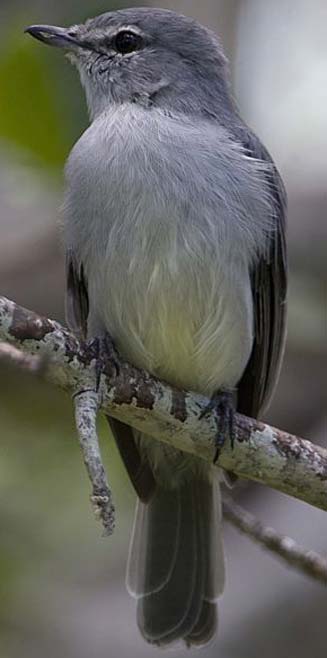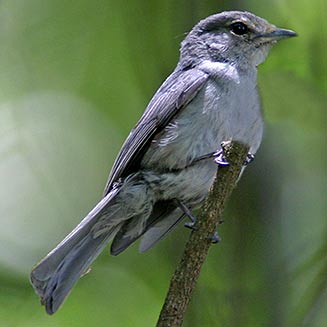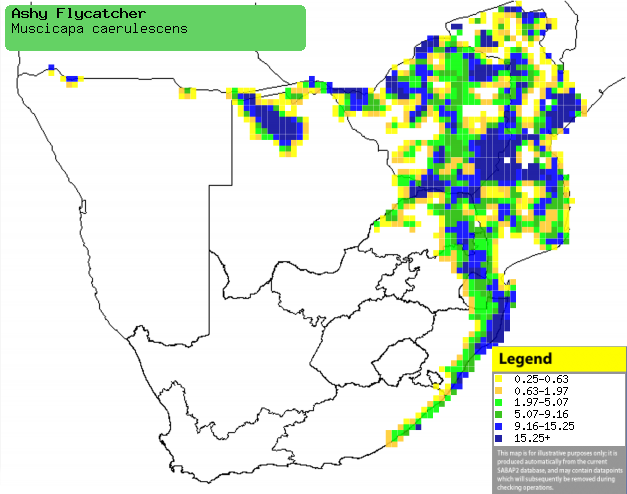|
Muscicapa caerulescens (Ashy
flycatcher, Blue-grey flycatcher)
BlougrysvlieŽvanger [Afrikaans]; Blauwgrijze
vliegenvanger [Dutch]; Gobemouche ŗ lunettes [French]; Schieferschnšpper
[German]; Papa-moscas-azulado [Portuguese]
Life
> Eukaryotes >
Opisthokonta
> Metazoa (animals) >
Bilateria >
Deuterostomia > Chordata >
Craniata > Vertebrata (vertebrates) > Gnathostomata (jawed
vertebrates) > Teleostomi (teleost fish) > Osteichthyes (bony fish) > Class:
Sarcopterygii (lobe-finned
fish) > Stegocephalia (terrestrial
vertebrates) > Tetrapoda
(four-legged vertebrates) > Reptiliomorpha > Amniota >
Reptilia (reptiles) >
Romeriida > Diapsida > Archosauromorpha > Archosauria >
Dinosauria
(dinosaurs) > Saurischia > Theropoda (bipedal predatory dinosaurs) >
Coelurosauria > Maniraptora > Aves
(birds) >
Order: Passeriformes > Family: Muscicapidae
> Genus: Muscicapa
 |
 |
 |
|
Ashy flycatcher, Thornybush Game Reserve, South
Africa. [photo Trevor Hardaker ©] |
Top right: Ashy flycatcher, Kruger National Park, South
Africa. [photo Trevor Hardaker ©]
Bottom right: Ashy flycatcher, Tanzania. [photo
Martin Goodey
©] |
Distribution and habitat
Occurs in patches in patches from West Africa to Somalia
south through DRC, Tanzania, Zambia and Angola to southern Africa. Here it is
locally fairly common in Mozambique, Zimbabwe, Swaziland and eastern South
Africa, extending west to northern Botswana and Namibia. It can occupy almost
any type of woodland excluding arid savanna, but it generally prefers clearings
and edges of evergreen forest, dense thickets in woodland, riverine woodland and
gardens.
|
 |
|
Distribution of Ashy flycatcher in southern Africa,
based on statistical smoothing of the records from first SA Bird Atlas
Project (©
Animal Demography unit, University of
Cape Town; smoothing by Birgit Erni and Francesca Little). Colours range
from dark blue (most common) through to yellow (least common).
See here for the latest distribution
from the SABAP2. |
Food
It mainly eats insects, which it catches in sallies from a
perch, catching prey from the air or the tree canopy and gleaning food from
leaves and branches. The following food items have been recorded
in its diet:
- Insects
- Small fruit
- Geckos
Breeding
- The nest is built by both sexes, consisting of a bulky cup built of plant
fibres such as thin bark strips, dry grass, rootlets, green moss and spider
web, lined with finer plant material. It is typically placed in a cavity in
a tree trunk, fork between thick branches, crevice in bark, shallow hole in
a tree stump or under the eaves of a veranda.
- Egg-laying season is from about September-January.
- It lays 2-4 eggs, which are incubated for about 14 days.
- The chicks are fed by both parents, leaving the nest after about 14
days.
Threats
Not threatened.
References
-
Hockey PAR, Dean WRJ and Ryan PG 2005. Roberts
- Birds of southern Africa, VIIth ed. The Trustees of the John Voelcker
Bird Book Fund, Cape Town.
|
